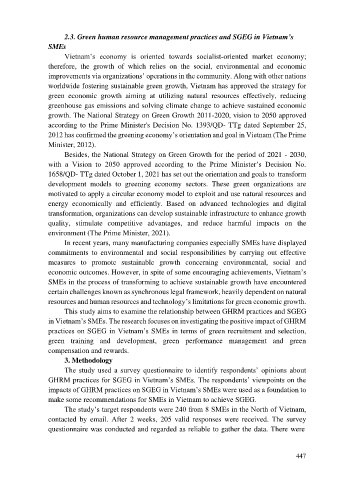Page 455 - Ebook HTKH 2024
P. 455
2.3. Green human resource management practices and SGEG in Vietnam’s
SMEs
Vietnam’s economy is oriented towards socialist-oriented market economy;
therefore, the growth of which relies on the social, environmental and economic
improvements via organizations’ operations in the community. Along with other nations
worldwide fostering sustainable green growth, Vietnam has approved the strategy for
green economic growth aiming at utilizing natural resources effectively, reducing
greenhouse gas emissions and solving climate change to achieve sustained economic
growth. The National Strategy on Green Growth 2011-2020, vision to 2050 approved
according to the Prime Minister's Decision No. 1393/QD- TTg dated September 25,
2012 has confirmed the greening economy’s orientation and goal in Vietnam (The Prime
Minister, 2012).
Besides, the National Strategy on Green Growth for the period of 2021 - 2030,
with a Vision to 2050 approved according to the Prime Minister’s Decision No.
1658/QD- TTg dated October 1, 2021 has set out the orientation and goals to transform
development models to greening economy sectors. These green organizations are
motivated to apply a circular economy model to exploit and use natural resources and
energy economically and efficiently. Based on advanced technologies and digital
transformation, organizations can develop sustainable infrastructure to enhance growth
quality, stimulate competitive advantages, and reduce harmful impacts on the
environment (The Prime Minister, 2021).
In recent years, many manufacturing companies especially SMEs have displayed
commitments to environmental and social responsibilities by carrying out effective
measures to promote sustainable growth concerning environmental, social and
economic outcomes. However, in spite of some encouraging achievements, Vietnam’s
SMEs in the process of transforming to achieve sustainable growth have encountered
certain challenges known as synchronous legal framework, heavily dependent on natural
resources and human resources and technology’s limitations for green economic growth.
This study aims to examine the relationship between GHRM practices and SGEG
in Vietnam’s SMEs. The research focuses on investigating the positive impact of GHRM
practices on SGEG in Vietnam’s SMEs in terms of green recruitment and selection,
green training and development, green performance management and green
compensation and rewards.
3. Methodology
The study used a survey questionnaire to identify respondents’ opinions about
GHRM practices for SGEG in Vietnam’s SMEs. The respondents’ viewpoints on the
impacts of GHRM practices on SGEG in Vietnam’s SMEs were used as a foundation to
make some recommendations for SMEs in Vietnam to achieve SGEG.
The study’s target respondents were 240 from 8 SMEs in the North of Vietnam,
contacted by email. After 2 weeks, 205 valid responses were received. The survey
questionnaire was conducted and regarded as reliable to gather the data. There were
447

